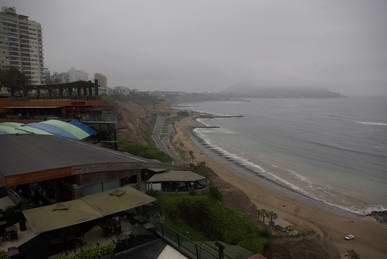12 September, Lima
A grey, but warm day, with the usual low cloud drifting over the city
from the cold Pacific Ocean. A day of city sightseeing, and for me
repeat visits to the monastery of San Francisco and the Cathedral. The
old railway station behind the Presidential Palace has been restored
since my last visit two years ago, and is now a centre for Peruvian
Literature. I ventured in, mainly to try and visualise what it must
have looked like as a station. This proved hard until I realised that
the platforms were at a lower level and at a right angle to the main
building; the main building being essentially an elaborate staircase to
drop down to the level of the lines. To the side of the building, which
contained various exhibits on Peruvian literature was the 'Author's
Avenue', where at the time I went there were three authors selling
their works. They each tried to persuade me that my Spanish was good
enough to be able to read their books, but I was not convinced! Maybe
after three more weeks in Peru.In the afternoon Ricardo, our pony-tailed philosophical guide, took us to the Larco Herrera museum, which displayed a minute percentage of the items, mainly pottery, collected by Señor L H himself. An adjacent store had cabinets piled high with similar items - thousands and thousands of mostly pre-Inca civilisation artefacts. Ignoring the display of erotic pottery, I found that the most interesting objects were the ones showing faces: from 2000 year-old feline figures on pots, through to the funerary masks (on this postcard) from the Chancay civilisation (14th -16th century).
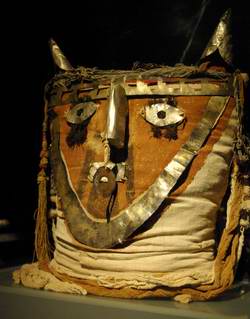
13 September, Arequipa
We escaped the grey morning of Lima by flying to Arequipa. As we broke through the coastal belt of clouds we could see distant snowy Andean peaks. The landscape over which we flew was an arid plateau, sculpted by water leaving a pattern of dry valleys and wrinkles in the sandy-coloured rock like the veins in a carpet of dry leaves. I checked off the snow-topped volcanoes as we passed: Coropuna, Ampato and, looming over Arequipa, Chachani and El Misti, and could see the lower reaches of Colca Canyon too.The real gem in Arequipa is the Monasterio de Santa Catalina, a 16th century convent where the well-to-do sent their unwanted daughters, along with a servant, to spend a sheltered and cosseted life. As each nun (or several related nuns) each had their own dwelling complete with kitchen the convent resembles a small Andalucian town of narrow streets and single storey flat-roofed stone dwellings. It was only in the mid 1800s that the Pope thought this wasn't one & the order returned to communal living. This tourism thing is exhausting, and we were cultured out by 17.30, but just had time to head up to a rooftop bar to watch the sunset over the main square, the Plaza de Armas. On this postcard El Misti is just illuminated by a pink glow - pity about the TV mast in the foreground!
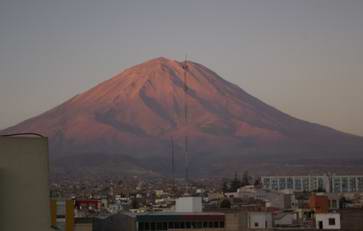
14 September, Chivay (Colca Canyon)
Today we drove over the highest point of our whole trip at about
4,900m, so higher than Mont Blanc. This always means that most of the
group were nervous about the effects of the altitude, but by drinking
plenty of water and coca tea & sucking coca sweets there were
only a couple of people unable to join the afternoon trip to the hot
pools in Chivay. How delicious to wallow in water at 39° in
glorious sunshine surrounded by the rocky cliffs of Colca Canyon, and
at 3,600m altitude.Before this we were lucky to see several herds of vicuña (the wild ancestor of the llama & alpaca) grazing on the dry & spiky ichu grass. In one spot although the vicuña were more distant, they were gambolling around the remaining pools in a dried up lake, with the north side of El Misti in the background (see postcard!).
The altitude still affected most people in a mild way, mostly headaches, but two were missing for dinner nevertheless.
At 9pm a knock at the door, and a hot-water bottle was delivered!
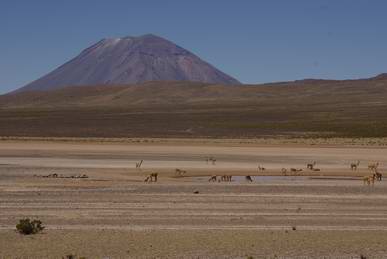
15 September, Chivay (Colca Canyon)
Crawled in breakfast at 05.45, as we were due off at 06.30 to head down the Colca valley to the viewpoint at Cruz del Condor in order to see.....condors, hopefully. The first part of the valley from Chivay is quite wide, and filled with stone-walled fields and terraces. As the road climbs above the valley floor the view down is filled with curving terraces, some ploughed, some with stubble, and some green with alfalfa crops mainly. Water bubbled down the hillsides in small channels to feed the ditches along the terraces. The terraces pre-date the Incas.We walked the last stretch to the condor viewpoint and, inevitably, the first two condors soared up above the viewpoint before we reached it. If only the coach hadn't had a flat tyre 10 km before we arrived! Our patience was rewarded by several more appearing over the next hour, followed by at least one eagle. Nearer to our standpoint a giant humming bird was feeding on an aloe flower, and obliged the photographers by being closer and more predictable than the condors.
After an afternoon walk and buying fruit in the local market I climbed up the hill behind our hotel, where I had spotted an old stone watch tower. Behind the watch tower on the hill were a dozen stone 'igloos'. Stone lined paths criss-crossed the hill and the main one led down to an amphitheatre with a rectangular hollow and a stone bowl at the centre. The whole site radiated a spiritual feeling - was this a pre-Inca site, why were the 'huts' so small, what happened in the amphitheatre? So many questions.
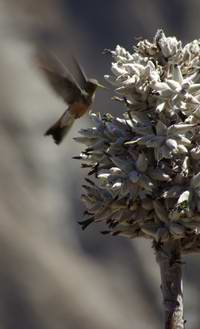
16 September, Puno
This seems to be turning into a wildlife trip. As we were heading back over the 4,900m pass on our way from Chivay to Puno someone spotted a viscacha in the rocks, conveniently near the viewpoint we were stopping at anyway. This member of the chinchilla family suns itself in the mornings and evenings, but is hard to spot due to its rocky colouring. It posed for us for a while, and then off we went across miles and miles of the high plateau with the baking sun and the icy wind competing for supremacy - only noticed by us, of course, when we got out of the coach, notably for a very windy lunch.Puno is a lively city slowly climbing up the hills that surround the bay on which the city is located. Steep straight narrow streets climb up the hill from the centre, ignoring the lie of the land. The centre was busy as we arrived in the afternoon, but it was busier in the evening when I went out after dinner. Teams of dancers representing different college or university faculties were parading noisily round the streets, ending up in the main square. Think teenage morris dancers with flashy cowboy boots (with bells on) accompanied by a brass band or massed pan pipes and some large drums. Such energy, and a friendly competitive atmosphere. The main pedestrian street had more shops open at 21.30 than it did in the afternoon, and the streets were more crowded - the odd tourist, many students and the occasional woman in traditional dress, including the undersized bowler hat that is the norm here.
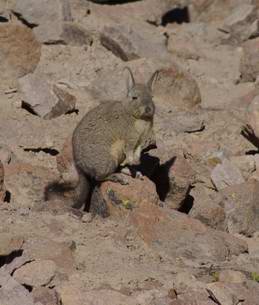
17 September, Puno
After a fantastic day out on Lake Titicaca visiting the Uros floating islands, walking on Taquile island, and visiting the old steamship Yavari, we came back to mayhem in Puno. The streets from the port were clogged with traffic as teams of dancers were slowly progressing through the town centre. Last nights performances must have been practices, for this was on altogether a larger scale. They were processing as we came off the boat at 17.30, and were still going strong after our dinner in a local restaurant at 21.30. The noise didn't subside till after 1am! Each faculty of the university had its own band and costume. Most of the faculties numbered over 40 dancers and musicians. Trumpets and bass drums provided the loudest noises, closely followed by euphoniums and pan pipes. The costumes were unbelievably intricate and showy. My favourites were the silver shiny face masks and helmets with integral pipes (the smoking variety). Strangely the girls seemed to be wearing less than the men. The total energy being expended was astounding. The parade wound round the Plaza de Armas and in front of the Cathedral where there was a podium. Teams were announced as they performed in front of the podium, and we gather they were being judged too. What a joyous occasion; old women and children sat on the kerb, watching, and crowds stood behind them. This was fine, but we had to cross the parade route twice just to get to our restaurant; it took some time to get there.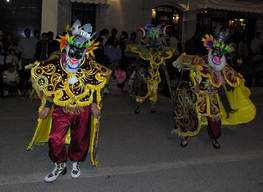
18 September, Cusco
This holiday is a series of very early starts, followed by long days - no time wasted & no energy after dinner to do anything. So it was that at 07.00 we set off walking from the hotel, across in front of the cathedral, to reach our coach. We followed the porters wheeling our suitcases as we didn't have a clue where the coach was parked - each time it has been in a different place.Long drives in coaches can be boring, but this 380km journey to Cusco started well with a visit to the burial towers at Sullistani - huge stone towers built prior to 1000AD on this sacred peninsula in a lake in the crater of an extinct volcano. I could have stayed there all day, but Cusco called. In fact the travel agent in Cusco called, to say that due to a planned strike next week we would have to reorder our programme. This means we are off to Machu Picchu tomorrow. More to the point, this means another early start, in fact a full 15 minutes earlier than today.
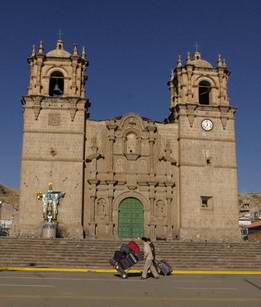
19 September, Aguas Calientes
Gathering in the hotel reception at 06.45 we were met with the news of another change to our programme; as a bridge on the railway had collapsed we would have to go by bus to Ollantaytambo and catch the train there, missing about 2 slow hours of the train journey. That still left an hour and a half down the Urubamba river though. Once on the train it was a stately swaying progress down the gorge with the vegetation getting thicker all the time until at Aguas Calientes the trees were thickly covered with epiphytes and flowers in shades of red were everywhere: pisanay trees, heliconias and impatiens abounded.We were lucky to have Ubaldo as a guide, a very spiritual person holding many Inca beliefs, and who I had had as a guide two years ago. Ubaldo took us around Machu Picchu, and with less pressure of time than on previous visits, told us several stories of his experiences spending the night at Machu Picchu, and the supernatural happenings that took place. Despite the crowds the impact of all the Inca terraces and buildings is still great, but several of us decided to return to Machu Picchu next morning at dawn when we thought it would be quieter.
Walking up the main street in Aguas Calientes was very similar to walking up the hill at Namche Bazaar in Nepal, only cleaner and neater. The town in filled with cafés and souvenir shops, but fewer trekking gear shops than Namche. We ate out in an atmospheric restaurant called Indio Feliz in a room decorated as a cross between a captain's cabin and an Inca themed saloon. The food was excellent & the best presented we had had so far. There was no exploring the night-life as we wanted to be up for dawn next day.
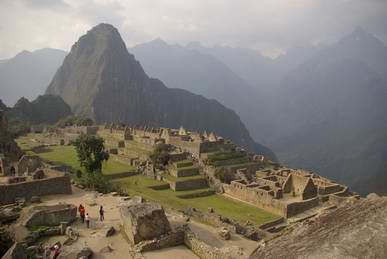
20 September, Cusco
The alarm went at 04.30, and six of us were out of the hotel at 05.20 to catch the first bus up to Machu Picchu. Unfortunately hundreds of other people had the same idea, so we arrived at the end of a long queue. It wasn't the first bus we caught, but the 'n'th bus, where n=>10 and <20! The site opens at 06.00, and we arrived at 06.10 to join the end of another long queue. Three of us wanted to climb up Huayna Picchu, which has a limit of 400 persons per day, with an hourly allocation. An official was working his way down the queue asking who wanted go up Huayna Picchu, and stamping the person's ticket. When he reached us all the early morning slots had been filled, and the earliest was 10.00-11.00 - not good given that our train was due to leave at 11.20.... I pleaded, and the guy eventually said that as we were only three we could head for the 07.00 slot and stamped our card - I was number 377. It was only when we reached the control gate that I realised that our ticket had the time 10.00-11.00 stamped on it! The official at the control gate was not impressed and was not to be persuaded that we could enter early, Just in the nick of time the original official from the queue arrived at the gate & an argument ensued in the gate office between the two officials. Queue-man had his way, and we were through!For the next two hours we climbed and descended the steepest and narrowest Inca steps I have ever seen! Mostly it was hard but straightforward, with wire rope handrails in difficult spots. However there were some stretches of exposed or unprotected stairways that needed a great deal of care. At one point we had to squeeze through a cave to follow the main trail to the rocky top. A great sense of achievement, and very atmospheric, if exceedingly hazy, views.
The rest of the day was a bit of a blur - the return train ride with dancing and a fashion show en-route, visits to Ollantaytambo and Pisac, and a return to Cusco in the dark. A great deal squeezed into one day as for the next two days we will be unable to leave Cusco because of the strike.
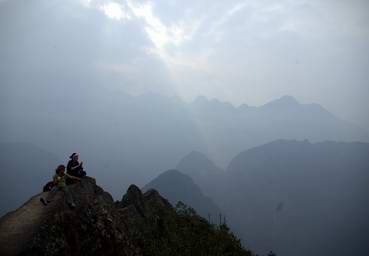
21 September, Cusco
We have a free morning, as it is thought that the strike will have less impact in the centre in the afternoon. The sound of drums, and the absence of traffic past the hotel, signalled the start of processions by strikers. They were mostly converging on the main Plaza de Armas, but some seemed to take a different route, ending up in different squares. The police presence was reasonably discrete, but some louder groups were accompanied by police with riot shields. However, there did not appear to be any trouble. Most central shops were closed, but elsewhere life went on. The cause of the strike is the proposal to build a dam & export water out of the Cusco region. One person was apparently killed in a demonstration in Espinar near the site of the dam, so the protests have escalated. The participants ranged from be-suited lawyers to traditionally dressed people from the countryside.In the afternoon we toured the Quoricancha and the Cathedral, both more crowded than usual as tourists were unable to visit outside Cusco, a real blow to those who were planning to go to Machu Picchu & haven't been able to change their plans.
The day finished off with a lively buffet meal at Don Antonio's, with colourful and sometimes masked dancers, and Beethoven, Bach and Mozart on pan pipes!
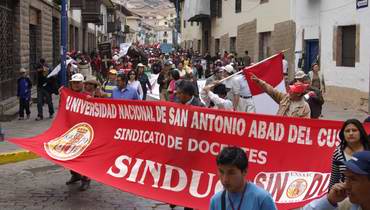
22 September, Cusco
Another day of planned strikes, so the planned tour of Inca sites near Cusco was postponed to the afternoon when, it was thought, the roads would be clear. Once again the centre of Cusco was wonderfully traffic-free, but there seemed to be fewer parading strikers than the day before.We assembled after lunch, and after a half-hour delay a mini-bus turned up for us. We headed up the winding steep road towards Saqsayhuaman and soon came across the remains of a barricade of boulders in the road, which the mini-bus negotiated easily. These obstacles occurred every 500m or so, and were mainly made of stones or boulders from adjoining steep slopes. One barricade had obviously comprised burning tyres judging by the black marks on the road and the coils of wire. Only once did our guide, Ubaldo, have to get out to move a stone.
At each site there was the inevitable line of stalls selling knitted alpaca items, carved stones, woven water-bottle holders and other sundry items. We became used to running this gauntlet, which was less wearisome than the procession of vendors, some only children, that circulated the outdoor tables in the cafés in Cusco centre.
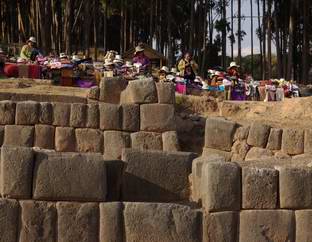
23 September, Iquitos
Another strike! The roads to the airport were blocked in the morning, so it was just as well that our local 'fixer', Eric, had changed our flight to Lima to a later one - not to avoid the strike, but to reduce the amount of time spent in the departure lounge in Lima. So we had another free morning in Lima, with all the museums open now, before heading to the airport.The flight to Lima, and the transfer to the Iquitos flight, all went very smoothly. As did the delivery of the in-flight snack - an identical cardboard box on each flight containing cheesy biscuits, a chocolate biscuit & a chocolate. So nourishing!
It was after dark when we landed in Iquitos and headed into town; overwhelmed by the heat and the buzz of ubiquitous motorcycles and tut-tuts.
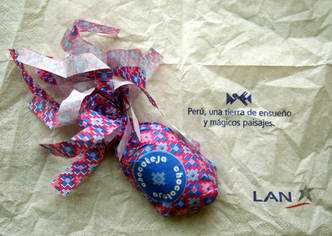
24 September, Heliconia Lodge
Before heading to the Bellavista port for our one and a half-hour speedboat trip downstream to Heliconia Lodge we were taken on a short bus tour of the back-streets of Iquitos, including the dried-up Lago Morona. The Amazon has been particularly low this year and, although it is rising, the Morona lagoon is still dry. We had a brief walk on one of the streets on stilts and were quickly surrounded by children eager to be photographed (and not begging). On the lake bed there were a number of floating houses, built on balsa tree-trunks, one of which was for sale. Floating on your drinking and waste water might not be such a healthy idea.....Arriving at the lodge I was surprised to find that they had installed a swimming pool since my last visit. A pity I didn't know as none of us had brought swimming gear. This resulted in a range of improvised swimming gear, as the heat was such that a dip was the only effective way to cool down.
In the afternoon we had our first taste of the lodge activities - either a river trip to try fishing for piranha (and spotting river dolphins) or a jungle walk. Relaxing, but hot!
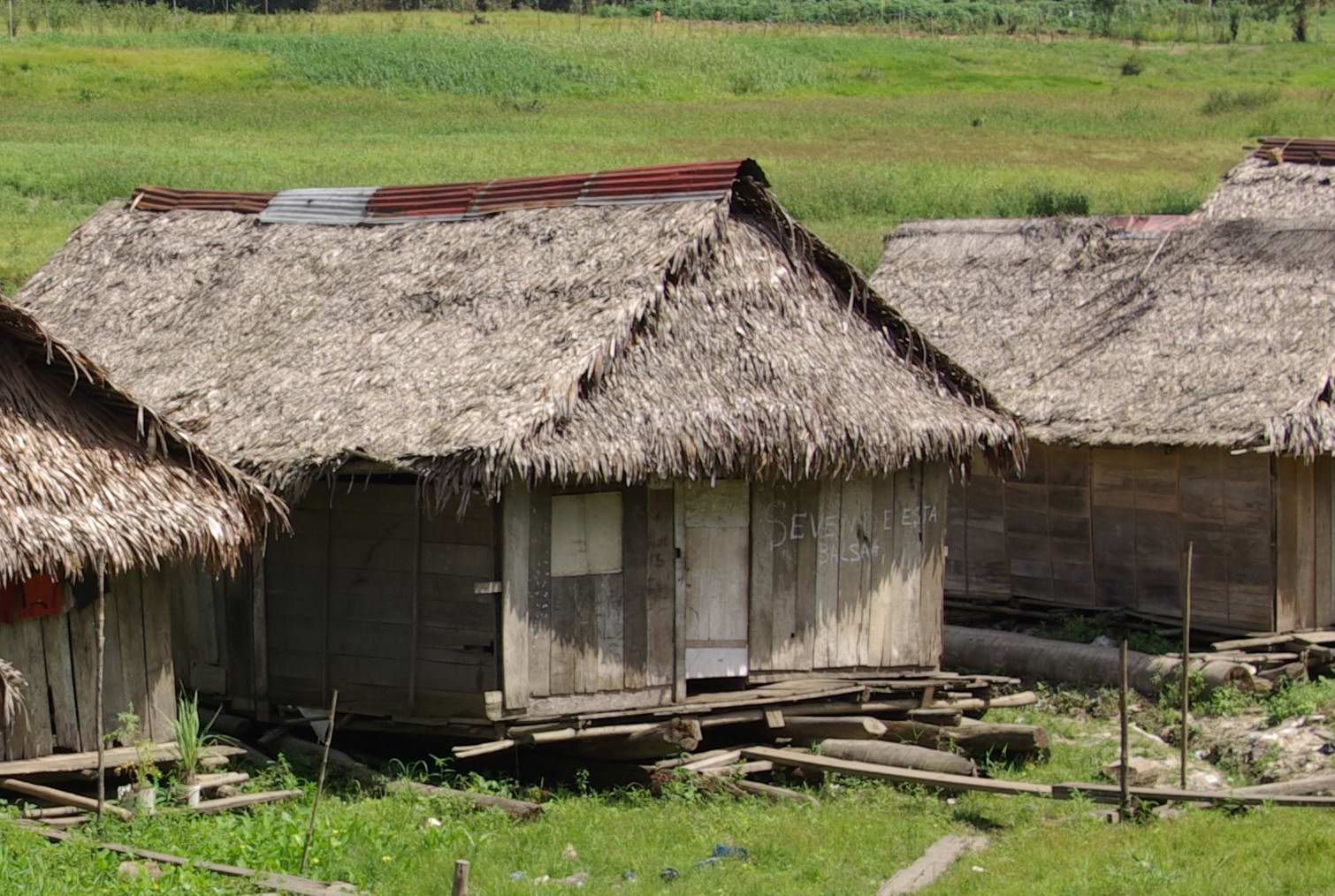
25 September, Heliconia Lodge
Most of us got up at 06.00 to do a spot of bird-watching from boats. The drivers headed the boats upstream for a distance, and then just cut the engines, so we floated silently back downstream seeing what we could on the way. On the way upstream the prize went to a roadside hawk, and on the way back down, a toucan. On the return one guide, Ricardo, stopped at a farm & got the owner to come down with a young anaconda (a mere 3m long), followed by his family with a baby sloth (1 month old) and a coati (I think!). The other guide, Llacko, didn't approve of this farmer's way of earning money & I guess the groups feelings on these animals being kept in captivity were also mixed.After a morning when those who had fished, walked, and vice versa, we headed off downstream to another example of the impact of tourism - we visited the Jaguar tribe and village. Having ditched their jeans and t-shirts for grass skirts we were 'entertained' with a speech in the local language and some dances. This may usually have been OK, but the thatched hut we were in seemed to act like a Turkish bath, and we were glad to escape outside to have a demonstration of (and chance to try) the poisoned dart.
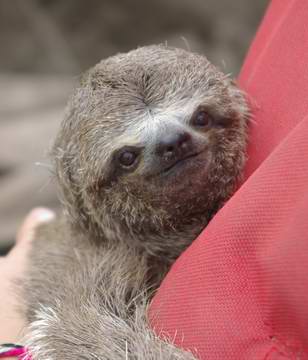
26 September, Lima
I got up early, although there was no early walk on the programme, and found that Ailie had also got up to watch birds and the guide, Llacko, had offered to take us along the river bank. We were rewarded with lots of sightings (by Llacko, some of which I did managed to see too!) and a view of a couple of large iguanas snoozing on branches, waiting for the sun to warm them up.It is a pity that the Amazon is so low, as the morning visit to view the giant water lilies, the Victoria Regias, brought us to a rather large puddle with a dozen fresh lily leaves (and many rotten ones), and no fresh flowers. The difference between the actual water level and the change in colour on the tree-trunks where the water level reaches in the wet season must have been 3-4 m. The disappointing display of lilies was forgotten after about the third sample of sugar-cane rum tried in a distillery downstream from the lodge. Probably the best bet for bringing home were the molasses, rather than the alcohol - delicious, even with dry biscuits.
After this we had a leisurely time to pack & return to Iquitos, followed by too long in the hotel lobby (it was too hot to got outside for long!) & then a late flight back to Lima. This resulted in us sitting down to a dinner of asparagus soup and then pepper steak, at 23.00. At least it was cool.
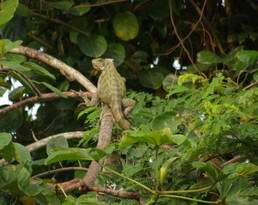
27 September, Lima
As usual, a very grey day in Lima, with the cloud right down almost to the Pacific Ocean. The flight back was not until the evening, so almost a full day with the delights of Lima.........For the group, a chance to wander and indukge in a final shopping experience (as if there hadn't been enough opportunities so far!), and for me a chance to deal with the paperwork, and give a large bag of dirty clothes to the adjacent laundry.